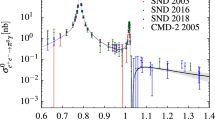Abstract.
Vacuum polarization integrals involve the vector spectral functions which can be experimentally determined from two sources: (i) e + e - annihilation cross sections and (ii) hadronic \(\tau\) decays. Recently results with comparable precision have become available from CMD-2 on one side, and ALEPH, CLEO and OPAL on the other. The comparison of the respective spectral functions involves a correction from isospin-breaking effects, which is evaluated. After the correction it is found that the dominant \(\pi\pi\) spectral functions do not agree within experimental and theoretical uncertainties. Some disagreement is also found for the \(4\pi\) spectral functions. The consequences of these discrepancies for vacuum polarization calculations are presented, with the emphasis on the muon anomalous magnetic moment. The work includes a complete re-evaluation of all exclusive cross sections, taking into account the most recent data that became available in particular from the Novosibirsk experiments and applying corrections for the missing radiative corrections. The values found for the lowest-order hadronic vacuum polarization contributions are \begin{eqnarray} a_{\mu}^{had,LO} = \left\{\begin{array{ll} (684.7 \pm 6.0_{exp} \pm 3.6_{rad}) 10^{-10} & [e^+e^--based] , \\ (709.0 \pm 5.1_{exp} \pm 1.2_{rad} \pm 2.8_{SU(2)}) 10^{-10} & [\tau -based] ,\end{array}\end{eqnarray} where the errors have been separated according to their sources: experimental, missing radiative corrections in e + e - data, and isospin breaking. The Standard Model predictions for the muon magnetic anomaly read \begin{eqnarray} a_{\mu} = \left\{ \begin{array}{ll} (11 659 169.3 \pm 7.0_{had} \pm 3.5_{LBL} \pm 0.4_{QED+EW}) 10^{-10} & [e^+e^--based] ,\\ (11 659 193.6\pm5.9_{had} \pm3.5_{LBL}\pm0.4_{QED+EW}) 10^{-10} & [\tau -based] , \end{array}\end{eqnarray} where the errors account for the hadronic, light-by-light scattering and electroweak contributions. We observe deviations with the recent BNL measurement at the 3.0 (e + e -) and 0.9 (\(\tau\)) \(\sigma\) level, when adding experimental and theoretical errors in quadrature.
Similar content being viewed by others
Author information
Authors and Affiliations
Additional information
Received: 27 August 2002 / Revised version: 10 January 2003 / Published online: 26 February 2003
RID="a"
ID="a" e-mail: davier@lal.in2p3.fr
RID="b"
ID="b" e-mail: simon.eidelman@cern.ch
RID="c"
ID="c" e-mail: hoecker@lal.in2p3.fr
RID="d"
ID="d" e-mail: zhangzq@lal.in2p3.fr
Rights and permissions
About this article
Cite this article
Davier, M., Eidelman, S., Höcker, A. et al. Confronting spectral functions from ee annihilation and \(\tau\) decays: consequences for the muon magnetic moment. Eur. Phys. J. C 27, 497–521 (2003). https://doi.org/10.1140/epjc/s2003-01136-2
Issue Date:
DOI: https://doi.org/10.1140/epjc/s2003-01136-2



